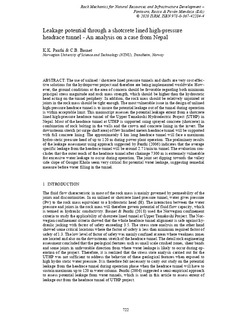| dc.contributor.author | Panthi, Krishna Kanta | |
| dc.contributor.author | Basnet, Chhatra Bahadur | |
| dc.date.accessioned | 2019-09-25T11:32:30Z | |
| dc.date.available | 2019-09-25T11:32:30Z | |
| dc.date.created | 2019-09-23T16:19:10Z | |
| dc.date.issued | 2019 | |
| dc.identifier.isbn | 978-0-367-42284-4 | |
| dc.identifier.uri | http://hdl.handle.net/11250/2618724 | |
| dc.description.abstract | The use of unlined / shotcrete lined pressure tunnels and shafts are very cost effective solutions for the hydropower project and therefore are being implemented worldwide. However, the ground conditions at the area of concern should be favorable regarding both minimum principal stress magnitude and rock mass strength, which should be higher than the hydrostatic head act-ing on the tunnel periphery. In addition, the rock mass should be relatively unjointed or joints in the rock mass should be tight enough. The most vulnerable issue in the design of unlined high-pressure headrace tunnel is to insure the potential leakage out of the tunnel during operation is within acceptable limit. This manuscript assesses the potential leakage extent from a shotcrete lined high-pressure headrace tunnel of the Upper Tamakoshi Hydroelectric Project (UTHP) in Nepal. Most of the headrace tunnel at UTHP is supported suing sprayed concrete (shotcrete) in combination of rock bolting in the walls and the crown and concrete lining in the invert. The downstream stretch (at surge shaft area) of few hundred meters headrace tunnel will be support-ed with full concrete lining. The approximately 8 km long headrace tunnel will face a maximum hydro-static pressure head of up to 120 m during power plant operation. The preliminary results of the leakage assessment using approach suggested by Panthi (2006) indicates that the average specific leakage from the headrace tunnel will be around 2.7 l/min/m tunnel. The evaluation concludes that the outer reach of the headrace tunnel after chainage 7300 m is extremely vul-nerable for excessive water leakage to occur during operation. The joint set dipping towards the valley side slope of Gongar Khola seem very critical for potential water leakage, suggesting re-medial measure before water filling in the tunnel. | nb_NO |
| dc.language.iso | eng | nb_NO |
| dc.publisher | CRC Press | nb_NO |
| dc.relation.ispartof | Rock Mechanics for Natural Resources and Infrastructure Development | |
| dc.title | Leakage potential through a shotcrete lined high-pressure headrace tunnel - An analysis on a case from Nepal | nb_NO |
| dc.type | Chapter | nb_NO |
| dc.description.version | acceptedVersion | nb_NO |
| dc.source.pagenumber | 722-728 | nb_NO |
| dc.identifier.cristin | 1727971 | |
| dc.relation.project | Norges forskningsråd: 257588 | nb_NO |
| dc.description.localcode | Locked until 3.9.2020 due to copyright restrictions. This is an Accepted Manuscript of a book chapter published by Routledge/CRC Press in [Rock Mechanics for Natural Resources and Infrastructure Development] on [3 September 2019], available online: https://doi.org/10.1201/9780367823177 | nb_NO |
| cristin.unitcode | 194,64,90,0 | |
| cristin.unitname | Institutt for geovitenskap og petroleum | |
| cristin.ispublished | true | |
| cristin.fulltext | postprint | |
| cristin.qualitycode | 1 | |
